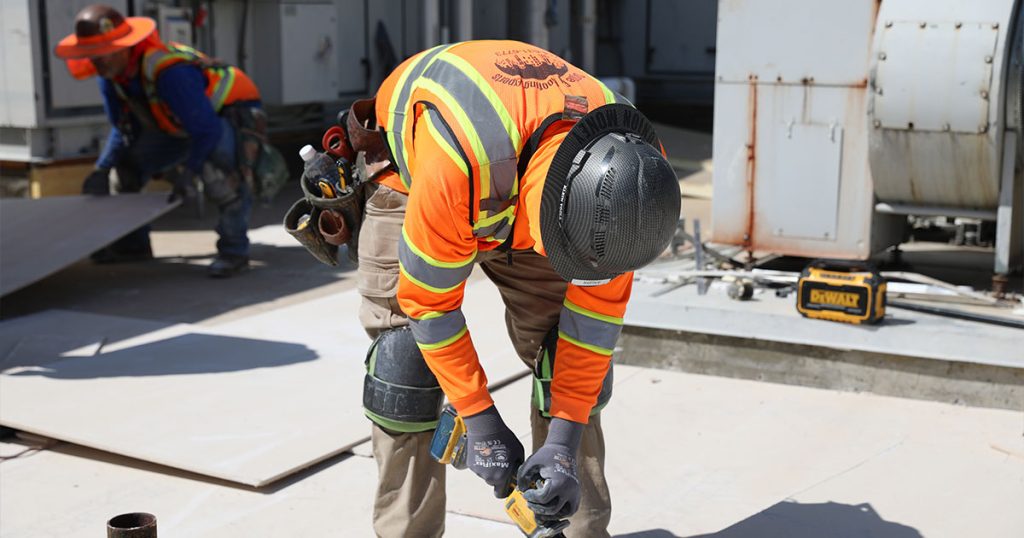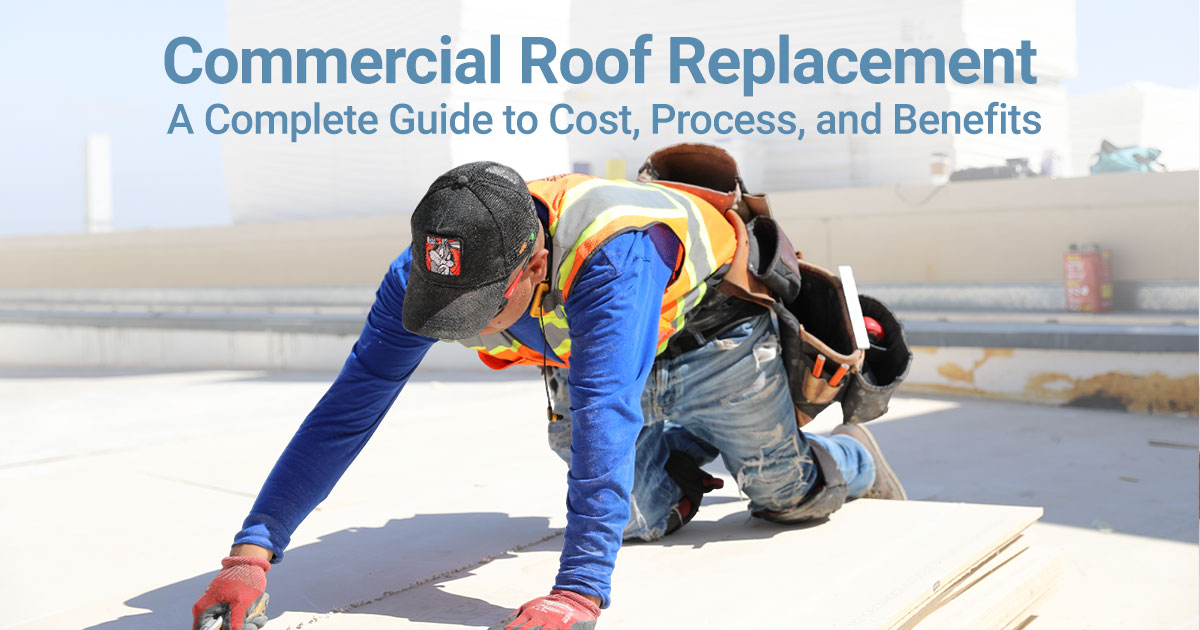Is your commercial roof showing signs of age? Maybe it’s ponding water after every rain, or the same leaks keep returning no matter how many patches you apply. Perhaps your energy bills are creeping up, or your roof is nearing the end of its lifespan.
At Single Ply Roofing Experts, we’ve replaced hundreds of commercial roofs across California—retail centers, warehouses, office buildings, manufacturing facilities, schools, and more. We understand that commercial roof replacement is a major investment. Done correctly, it can significantly reduce operating costs, increase property value, and give you peace of mind for decades.
In this guide, we’ll walk you through everything you need to know about commercial roof replacement: how to know when it’s time, what it costs, the step-by-step process, and the benefits of making the right long-term decision.
What Is Commercial Roof Replacement?
Commercial roof replacement is the complete removal of an existing roofing system and the installation of a new one designed to meet modern performance, safety, and energy standards.
Unlike repairs or coatings, which address specific issues or extend life temporarily, a full replacement provides a new structural and waterproofing system from the substrate up.
The process typically involves:
- Tearing off the existing roof layers
- Inspecting and repairing the decking or insulation
- Installing a new high-performance membrane (TPO, PVC, EPDM, or built-up roofing)
- Rebuilding flashing, drainage, and insulation to current standards
For flat or low-slope roofs, TPO roof replacement is one of the most popular choices due to its reflectivity, energy efficiency, and long service life. Replacement is not just about stopping leaks—it’s about giving the building a stronger, more efficient shield for the next 20 to 30 years.
Signs You May Need a Roof Replacement
Not every roof issue calls for immediate replacement. But there are clear signs that the existing system is reaching the end of its functional life. Common indicators include:
- Recurrent leaks despite repeated repairs
- Pooling or standing water that doesn’t drain after 48 hours
- Visible cracks, bubbles, or torn membranes across large areas
- Rising energy bills due to degraded insulation and reflectivity
- A roof that is nearing or exceeding its expected lifespan (typically 15–25 years depending on material)

In our experience, if more than 25% of your commercial roof is compromised, full replacement often becomes the smarter and more cost-effective long-term investment. Piecemeal patching on an aging system rarely holds up under heavy weather or years of UV exposure.
Commercial Roof Replacement Cost Breakdown
Cost is often the first question we get, and for good reason. Commercial roof replacement is a significant capital expense, but understanding where the numbers come from helps clarify the return on investment.
Average cost per square foot generally depends on the roofing system selected, roof size, accessibility, and the scope of tear-off required. On average, flat roof replacement ranges between the mid and upper single digits per square foot, with more complex systems or multiple layers costing more.
Key factors influencing commercial roofing cost include:
- Roof Size and Complexity: Larger roofs benefit from economies of scale, but complex layouts with multiple penetrations require more labor.
- Accessibility: Roofs with limited access or requiring cranes and staging can increase installation time and cost.
- Tear-Off and Disposal: Removing multiple existing layers or damaged insulation adds time and disposal fees.
- Material Choice: TPO, PVC, EPDM, or built-up each have different price points and lifespans.
- Insulation Upgrades: Adding or replacing insulation improves energy efficiency but impacts upfront cost.
When evaluating cost, focus on value over price. A modern TPO system, for example, can reduce energy costs enough to offset its installation expense in under five years, all while providing decades of reliable performance and extended warranties.
The Roof Replacement Process (Step-by-Step)
One of the things that sets SPRE apart is our methodical, safety-first approach to each commercial roof replacement. Here’s what to expect when working with us:
1. Initial Inspection & Assessment
We begin with a thorough inspection of the existing roofing system, identifying visible damage, moisture intrusion, insulation condition, and structural integrity. This allows us to determine whether full replacement is necessary and to define the scope of work accurately.
2. Proposal & Estimate
You’ll receive a clear, itemized proposal that outlines material choices, timelines, costs, and options for insulation or drainage upgrades. Transparency is key—we want you to understand every line of the investment.
3. Old Roof Removal
Our team carefully removes the existing roof layers while maintaining a clean and safe job site. Debris is managed efficiently to minimize disruption to your business operations.
4. Substrate Repair & Preparation
Any damaged decking or insulation is repaired or replaced. A clean, structurally sound substrate ensures proper adhesion and performance of the new roofing system.
5. Installation of the New Roofing System
We install the selected commercial roofing system using manufacturer-approved methods. This includes proper insulation layering, membrane welding, flashing integration, and drainage optimization to create a fully watertight barrier.
6. Final Inspection & Warranty Activation
Before completion, our quality assurance team conducts a comprehensive inspection. Once approved, manufacturer and labor warranties are activated, giving you documented protection for years to come.
Benefits of Commercial Roof Replacement
A properly executed commercial roof replacement provides far more than just a new roof. It strengthens the entire building’s performance and marketability.
- Extended Lifespan: Modern commercial roofing systems can last 20 to 30 years with proper maintenance.
- Energy Efficiency: Reflective membranes reduce heat absorption and lower cooling costs.
- Reduced Maintenance: A new system eliminates chronic leaks and frequent service calls.
- Increased Property Value: Prospective buyers and tenants value buildings with new, warrantied roofs.
- Warranty Protection: Manufacturer and labor warranties provide peace of mind and long-term protection.

When SPRE replaces your roof, we’re not just installing a system—we’re securing your investment for decades.
Common Mistakes to Avoid During Roof Replacement
Over the years, we’ve seen many avoidable errors that lead to expensive problems later. Here are the most critical mistakes to avoid:
- Choosing the cheapest contractor over quality: Low bids often mean shortcuts, unskilled labor, or subpar materials.
- Ignoring drainage redesign: A new roof with the same flawed drainage will recreate old problems.
- Overlooking insulation upgrades: Skipping insulation improvements misses out on significant energy savings.
- Skipping post-installation inspections: Final inspections catch issues before warranties are activated.
Cutting corners on materials or workmanship may save money today, but it usually costs far more tomorrow.
Expert Tips from Single Ply Roofing Experts
From decades of hands-on experience, here are our top tips for a smooth and successful roof replacement:
- Schedule replacements during mild weather to avoid unnecessary delays and weather-related complications.
- Request full documentation for warranties covering both materials and labor.
- Combine replacement with insulation and drainage upgrades to maximize ROI and system longevity.
- Establish a preventive maintenance program immediately after replacement to keep the system performing like new.

These steps help ensure your new commercial roof delivers its full lifespan and value.
FAQs about Commercial Roof Replacement
How long does a commercial roof replacement take?
The timeline depends on roof size, complexity, and weather. Most projects range from a few days to several weeks. We plan our work to minimize disruption to your daily operations and keep the process efficient.
What’s the average lifespan of a new commercial roof?
Modern systems such as TPO or PVC typically last 20 to 30 years with proper maintenance. Factors like climate, foot traffic, and drainage all affect lifespan.
Can my business stay open during replacement?
In most cases, yes. We coordinate work in phases, use safety barriers, and plan schedules to keep your business operational while we work above.
What’s the best roofing material for flat commercial roofs?
TPO is one of the most popular due to its energy efficiency, durability, and reflective properties. However, the best system depends on your building’s structure, budget, and performance goals.
Do I need permits for roof replacement?
Yes, commercial roof replacements typically require permits. We handle all necessary permitting and ensure compliance with local building codes and regulations.
Secure Your Building with Professional Roof Replacement
Your roof protects everything beneath it—your employees, your equipment, and your business itself. When it’s time to replace it, trust the specialists who have built their reputation on quality, safety, and reliability.
At Single Ply Roofing Experts, we deliver precision, efficiency, and lasting performance with every commercial roof replacement we complete. Contact us today to schedule a professional inspection and receive a transparent, no-obligation estimate for your property.

